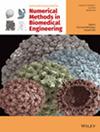Computational Modelling Using Uncertainty Quantification and Global Sensitivity for the Risk of Hernia Repair Fixation Failure
Abstract
Despite being a common procedure, abdominal hernia treatments still require improvement due to the number of relapses and other postoperative issues. In silico testing can be employed to predict the behavior of the complex abdominal wall and implant systems. Here, uncertainty quantification and sensitivity analysis are required in order to optimize the parameters of hernia repair models. This paper concerns the modeling of an abdominal wall and implant using the finite element method. A Gasser-Ogden-Holzapfel (GOH) material model is used for the abdominal wall and an orthotropic material model for the implant. The parameters of the GOH model and the orientation of the implant are assumed to be uncertain. Regression-based polynomial chaos expansion is used as a meta-modeling method for uncertainty propagation and global sensitivity analysis. The maximum force in the connection between the implant and native tissue is considered as the quantity of interest. A failure risk criterion is also defined and presented. It has been found that the significance of the material parameters depends on the type of implant that is analyzed. Likewise, the risk of connection failure varies considerably depending on the implant used. Models with different types of implant produce very diverse results. Moreover, these differences also appear in the global sensitivity index and the risk of connection failure. This would indicate that specific implant designs and material properties are crucial to the success of hernia repair surgery.


 求助内容:
求助内容: 应助结果提醒方式:
应助结果提醒方式:


